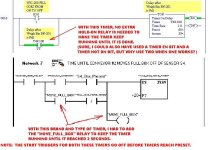ceilingwalker
Lifetime Supporting Member
Good day all. I have what is probably going to amount to a "silly" question pertaining to timers in RSLogix500. What is the difference between a timer being enabled and a timer timing? Are they not functionally the same thing? I mean, if a timer is enabled, it is timing, yes? If I were using an RTO I could maybe see the signigance but for a TON, for example, they seem the same.




